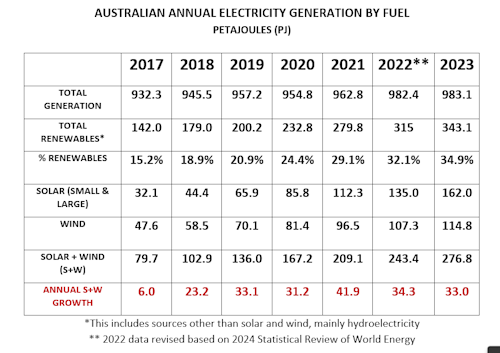The energy units used here are petajoules, PJ. They may be less familiar than traditional electrical units like kilowatt-hours or terawatt-hours but they now have a firm place in Australia's official statistics. Conversion to other units is simple, e.g. 1 PJ = 0.278 TWh. 1 TWh = 3.6 PJ.

The differences between the first two rows measure remaining contributions from fossil fuels (mainly coal and natural gas).
Advertisement
The critical numbers for annual clean energy growth from solar plus wind are highlighted in the last row. The table shows that prior to 2019 (only two points included here) growth rate of solar and wind output rose steeply. Then growth looks to have stabilised at around 35 PJ per annum for the next five years (to date). That is the true measure of growth under current plans.
How does it look in relation to estimated targets? Are we nearly there yet?
As I said above there should be two targets, one for Australia's existing power supplies, the other for future clean electricity requirement for replacing all fossil fuels.
The first is easy. The numbers for "% renewables" are in the third row of the table. If we assume clean generation keeps rising at the same 35 PJ per annum then that number will reach 100% in around 18 years, in 2042.
The second is tougher. There is as yet no agreed target, no agreed method for calculating it. That's partly because the "clean technologies" for many major industrial products now reliant on fossil fuels, like steel, fertiliser, explosives, plastics and cement, are yet to be developed (despite politicians always sounding confident – they have no idea). Without commercial trials and application there is no way of knowing the electricity requirements for those hypothetical processes.
However several other ways of making informed estimates have been published and they seem to be converging. These "educated guesses" suggest a figure at least 2.5 times today's electrical energy usage. Let's use that now as a first approximation, remembering it's rough and probably a bare minimum.
Advertisement
In 2023 Australia used 983 PJ of electricity. On that basis we would need 2.5 X 983, say 2460 PJ, to displace all fossil fuel use. Latest data for renewables generation is 343 PJ for 2023, which means another 2460 – 343 PJ to go. That is, we still need another 2120 PJ (rounded) solar and wind to reach the target.
Let's assume the solar/wind growth rate stays the same as for the "% renewables" target, 35 PJ per annum. At that rate it would take 60 years. Certainly not high enough to it the tentative 2050 deadline, which is only 26 years away. To do that we'd need to raise the average annual increase to about 80 PJ per annum, 2.3 times faster than now. AEMO calls for a sixfold leap to reach net zero. Why the difference? It's hard to say on what has been published.
The conclusion we are stuck with is that total solar/wind energy output growth is now too slow to meet a conservative target.
Discuss in our Forums
See what other readers are saying about this article!
Click here to read & post comments.
15 posts so far.